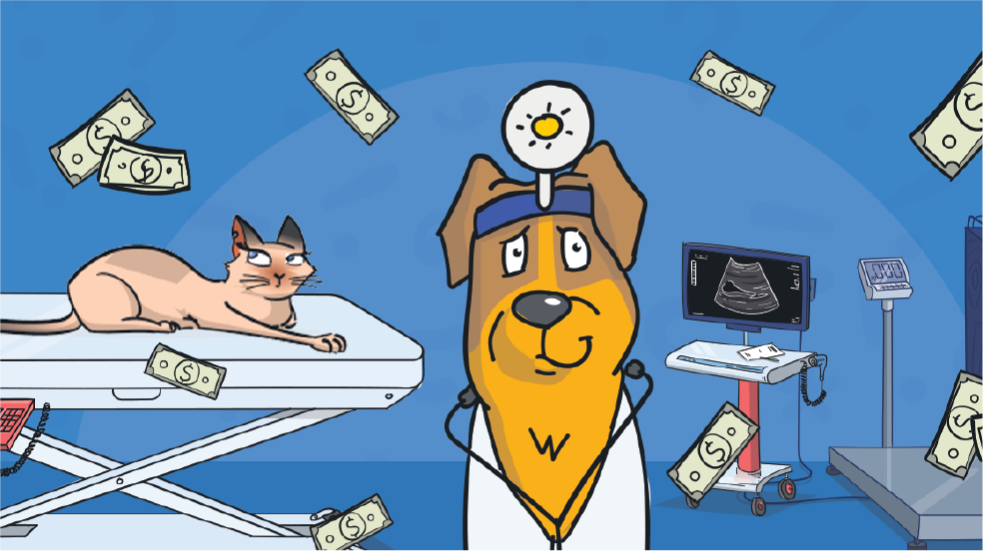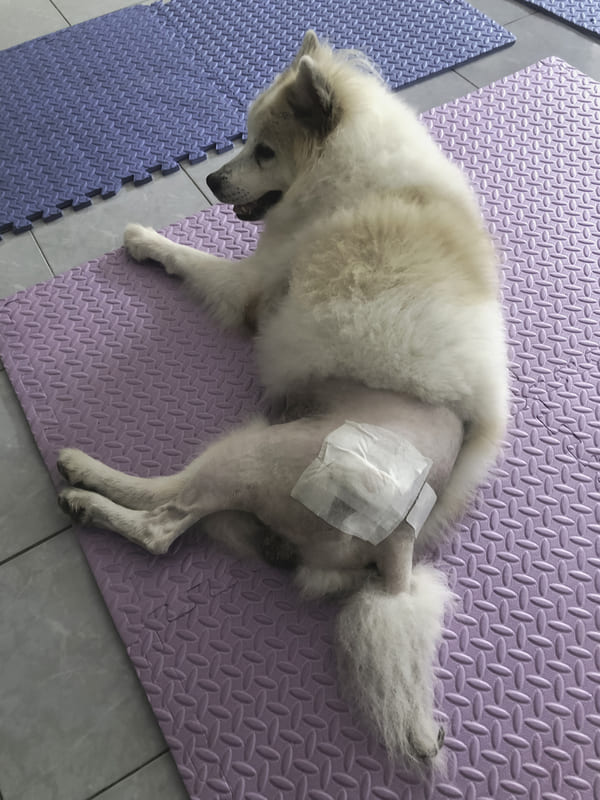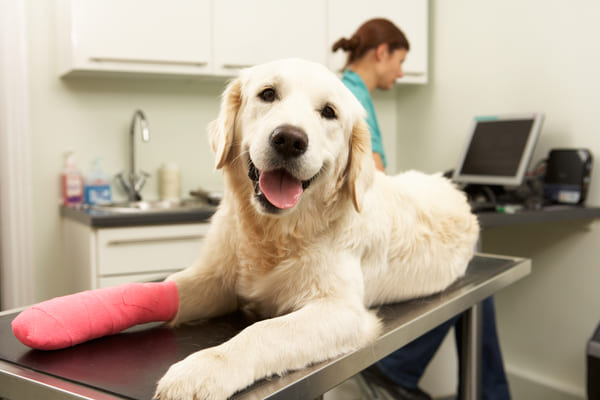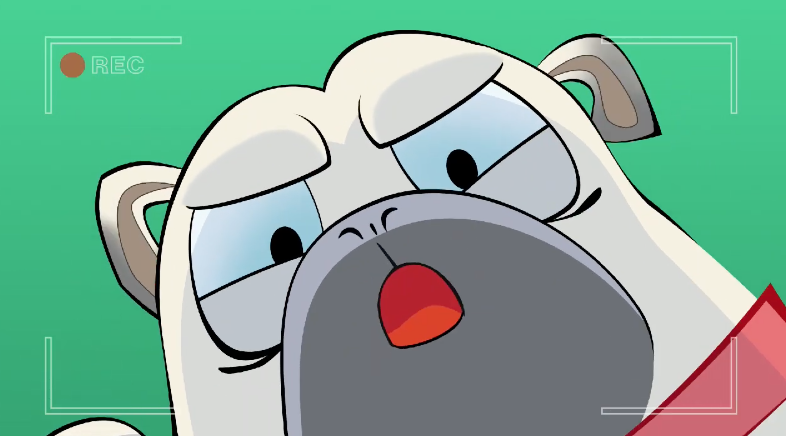

The Top 5 Most Expensive Procedures for Dogs
Emergency veterinary expenses can leave pet owners with budget-breaking bills and impossible decisions. Learn more about the costs of common procedures to plan your budget and better understand the value of pet insurance.

Writer Animalia Team
8 min read

Every pet owner dreads a health emergency. Even when pups pull through and make a full recovery, the cost of paying for medical treatment can mean going way over your planned budget. Sometimes, animal lovers must make impossible choices based on costs, giving up necessary, even life-saving treatment for sick pets.
The average cost of canine surgery in the U.S. rises each year, with the average procedure costing between $500 and $7,000. These rising costs are related to the increased price of pharmaceuticals, as well as the cost of researching and implementing the latest technologies, equipment, and procedures. To prepare yourself for the potential emotional and financial impacts of pet ownership, it’s a good idea to have an idea of how much common surgeries can cost. While it’s impossible to estimate the exact cost of medical care for an individual pet in a specific area, we can share average prices for common procedures.
Here’s what you should expect to pay for five common- and expensive- canine procedures.
1. Total hip replacement
Canine hip dysplasia is common in many large dog breeds. Replacing the ball and socket of the hip joint can restore a full range of motion and relieve symptoms, including pain. Total hip replacement may also be recommended for management of arthritis or in case of certain fractures. The operation is similar to the one carried out on humans and involves replacing the head of the femur (the ball) and the acetabulum (the socket) with prosthetic implants. The ball is fashioned from a cobalt-chromium metal alloy, in case you were wondering, while the socket’s created from high-molecular-weight polyethylene plastic. The implants are secured in place with bone cement. Over 90% of dogs who undergo a total hip replacement make a full recovery. It can, however, be a long recovery process for an owner’s bank balance, especially if both hips need to be replaced- which is common with hip dysplasia. An alternative option to total hip replacement is a surgery called a femoral head ostectomy (FHO). This is considered a salvage procedure but can be an option to manage pain when a total hip replacement is not feasible.
- Average cost of surgery: $7,000 per hip (the implants themselves account for 35% of this cost!)

2. Gastrointestinal obstruction (foreign object removal)
Dogs, especially puppies, will swallow nearly anything they can get their mouths on. Just about everything is a suitable target for chewing, no matter how diligent pet owners are at keeping things picked and packed up. It’s no surprise, then, that a lot of dogs wind up with foreign objects blocking their digestive systems. Common culprits are dog toys, stones, and socks or underwear. Emergency surgery to remove the offending item is often necessary to avoid fluid loss, dehydration, and life-threatening damage to the intestines. Without veterinary intervention, your dog’s stomach or intestinal walls could even become perforated, leading to sepsis. Gastrointestinal obstructions may also be caused by an intussusception (intestinal segments “telescoping” into one another) or torsion (twisting of the intestines). Tumors can also cause GI obstructions and are more common in senior patients.
If you see your dog swallow an object, seek veterinary attention immediately. Sometimes, vomiting can be induced to bring up the object of concern. If you haven’t witnessed them swallowing something, signs of trouble might include vomiting, dehydration, a poor appetite, lack of bowel movement or obvious abdominal pain. If you suspect an obstruction, do not give your dog any food until they’ve seen a veterinarian. Do not try to induce vomiting at home. Occasionally, vets can remove small objects from the stomach via endoscopy, but keep in mind that major surgery is required in most cases. Once the object has been removed and the incision is sutured, your dog should soon be up on their feet and back to their usual chewing habits after a day or so, though some cases do have a longer recovery time and involve hospitalization. Just be careful, as your dog has probably not learned their lesson.
- Average cost of surgery: $3,000 to $7,500
3. Tibial Plateau Leveling Osteotomy (TPLO)
You can’t stop an active dog from running, jumping, and bounding around. Unfortunately, this joie-de-vivre can get the better of dogs and lead to injuries such as torn cranial cruciate ligaments (CCL). Most dogs who develop this condition are not athletes, though, as most CCL injuries in dogs are caused by a degeneration of the ligament rather than trauma, the main cause of CCL injuries in humans. This common condition causes instability in the knee joint and allows the tibia (shin bone) to move forward relative to the femur (thigh bone). When this occurs, the knee gives way and dogs start to limp. Tibial Plateau Leveling Osteotomy (TLPO) is a surgical procedure used to stabilize the knee and get pups comfortably back on their paws again. TPLO involves altering the angle of the top of the shin bone (the tibial plateau) to restabilize the knee joint, allowing for comfortable movement and support. During surgery, a curved cut is made in the tibia. The bone is then rotated before being stabilized with a plate and screws. Following TPLO, dogs typically make full recoveries and their long-term prognosis is positive. In fact, most will have a complete return to function after recovery and rehabilitation.
- Average cost of surgery: $4,500 to $7,500

4. Intervertebral Disc Disease Surgery (IVDD)
Sometimes, dogs’ intervertebral discs can become compressed or even extruded into the spinal canal, leading to pain and nerve damage. This process can be degenerative or traumatic, and leads to painful bulging, ruptured, herniated, or slipped discs. To relieve these symptoms, the diseased material may need to be removed surgically. Although this condition can affect any dog, it’s more common in smaller breeds and those with longer backs such as French Bulldogs, Basset Hounds, Shih Tzus, Pekingese, and Dachshunds. IVDD surgery can involve different techniques, depending on how severe your dog’s symptoms are and the location of the herniated disc. In most cases, the diseased disc material is removed through an incision made through the spine. The recovery period is often quite lengthy. It can take six to eight weeks before your dog is back to their usual active self, or sometimes even several months. The twist? If a herniated disc isn’t caught soon enough, some dogs may not regain full function following surgery. Essentially, the success of their recovery depends largely on how severe their condition was prior to surgery. Complications can include lack of return to function, damage to the spinal cord, infections, hemorrhage, etc.
- Average cost of surgery: $5,500 to $10,000
5. Gastropexy
Gastric dilatation and volvulus (GDV), commonly known as “bloat”, happens when a dog’s stomach twists, distends, and creates life-threatening complications. The condition often starts with a full stomach brought on by excessive gas, eating a large meal or drinking copious amounts of water. Some breeds are predisposed to bloat and can develop it without other factors involved. When the stomach twists and bloats, it puts pressure on the diaphragm and major blood vessels, leading to breathing and circulatory problems. If not treated promptly, death can occur. GDV is more common in larger breeds with barrel-chests such as German Shepherds, Great Danes, Saint Bernards, Old English Sheepdogs, and Standard Poodles.
Prophylactic (preventative) gastropexy is often recommended in young, healthy, GDV-prone breeds to reduce their risk of developing this life-threatening condition. The stomach is surgically attached to the abdominal wall to prevent twisting. The good news? The procedure can be carried out at the same time as their spay or neuter. When this preventative measure is taken, the risk of GDV is greatly reduced. Gastropexy is always performed as an emergency operation in patients presenting with GDV because the risk of GDV recurrence without it is over 50%. Although gastropexy was once a major abdominal operation, when performed prophylactically, it’s now often performed through a laparoscopic (very small) incision. Naturally, a smaller incision means less pain and fewer complications.
- Average cost for prophylactic surgery: $1,400
- Average cost for emergency surgery: $4,000 to $8,000
Protecting your pet
By now you can certainly see the value of protecting your beloved pet with pet insurance. Even though 53% of American households own a dog, only an estimated 2% of dogs are adequately insured. With one out of three dogs experiencing at least one medical emergency during their lives, this means countless pet owners face heartbreaking decisions.
Purchasing coverage while a dog is young typically means lower up-front costs and broader coverage options. However, while getting your dog Animalia’s dog insurance early is certainly wise, every dog will benefit from our extensive coverage. Give us a try today.





We offer the most
comprehensive coverage
out there
car with a spare tire for life’s bumps.
Having Animalia is like a pimped-out
Rolls Royce with a swimming pool
in the trunk.



Get your pet insurance quote
Pet type
- Dog
- Cat
What is your pet's name?
Zip code





